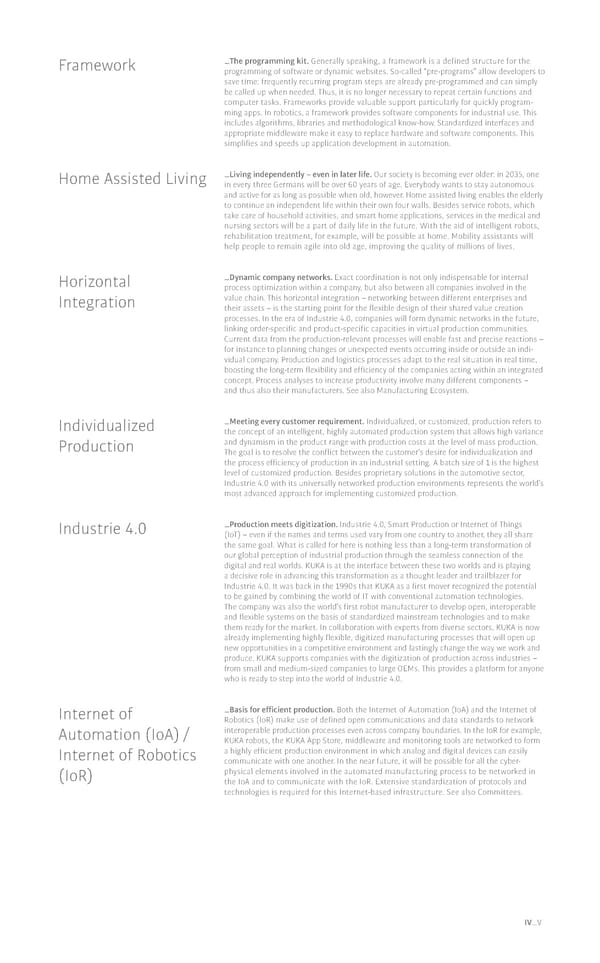Framework �The programming kit. Generally speaking, a framework is a defined structure for the programming of software or dynamic websites. So-called “pre-programs” allow developers to save time: frequently recurring program steps are already pre-programmed and can simply be called up when needed. Thus, it is no longer necessary to repeat certain functions and computer tasks. Frameworks provide valuable support particularly for quickly program- ming apps. In robotics, a framework provides software components for industrial use. This includes algorithms, libraries and methodological know-how. Standardized interfaces and appropriate middleware make it easy to replace hardware and software components. This simplifies and speeds up application development in automation. Home Assisted Living �Living independently – even in later life. Our society is becoming ever older: in 2035, one in every three Germans will be over 60 years of age. Everybody wants to stay autonomous and active for as long as possible when old, however. Home assisted living enables the elderly to continue an independent life within their own four walls. Besides service robots, which take care of household activities, and smart home applications, services in the medical and nursing sectors will be a part of daily life in the future. With the aid of intelligent robots, rehabilitation treatment, for example, will be possible at home. Mobility assistants will help people to remain agile into old age, improving the quality of millions of lives. Horizontal �Dynamic company networks. Exact coordination is not only indispensable for internal process optimization within a company, but also between all companies involved in the Integration value chain. This horizontal integration – networking between different enterprises and their assets – is the starting point for the flexible design of their shared value creation processes. In the era of Industrie 4.0, companies will form dynamic networks in the future, linking order-specific and product-specific capacities in virtual production communities. Current data from the production-relevant processes will enable fast and precise reactions – for instance to planning changes or unexpected events occurring inside or outside an indi- vidual company. Production and logistics processes adapt to the real situation in real time, boosting the long-term flexibility and efficiency of the companies acting within an integrated concept. Process analyses to increase productivity involve many different components – and thus also their manufacturers. See also Manufacturing Ecosystem. Individualized �Meeting every customer requirement. Individualized, or customized, production refers to the concept of an intelligent, highly automated production system that allows high variance Production and dynamism in the product range with production costs at the level of mass production. The goal is to resolve the conflict between the customer’s desire for individualization and the process efficiency of production in an industrial setting. A batch size of 1 is the highest level of customized production. Besides proprietary solutions in the automotive sector, Industrie 4.0 with its universally networked production environments represents the world’s most advanced approach for implementing customized production. Industrie 4.0 �Production meets digitization. Industrie 4.0, Smart Production or Internet of Things (IoT) – even if the names and terms used vary from one country to another, they all share the same goal. What is called for here is nothing less than a long-term transformation of our global perception of industrial production through the seamless connection of the digital and real worlds. KUKA is at the interface between these two worlds and is playing a decisive role in advancing this transformation as a thought leader and trailblazer for Industrie 4.0. It was back in the 1990s that KUKA as a first mover recognized the potential to be gained by combining the world of IT with conventional automation technologies. The company was also the world’s first robot manufacturer to develop open, interoperable and flexible systems on the basis of standardized mainstream technologies and to make them ready for the market. In collaboration with experts from diverse sectors, KUKA is now already implementing highly flexible, digitized manufacturing processes that will open up new opportunities in a competitive environment and lastingly change the way we work and produce. KUKA supports companies with the digitization of production across industries – from small and medium-sized companies to large OEMs. This provides a platform for anyone who is ready to step into the world of Industrie 4.0. Internet of �Basis for efficient production. Both the Internet of Automation (IoA) and the Internet of Robotics (IoR) make use of defined open communications and data standards to network Automation (IoA) / interoperable production processes even across company boundaries. In the IoR for example, KUKA robots, the KUKA App Store, middleware and monitoring tools are networked to form Internet of Robotics a highly efficient production environment in which analog and digital devices can easily communicate with one another. In the near future, it will be possible for all the cyber- (IoR) physical elements involved in the automated manufacturing process to be networked in the IoA and to communicate with the IoR. Extensive standardization of protocols and technologies is required for this Internet-based infrastructure. See also Committees. IV�V
 Embracing Industrie Page 94 Page 96
Embracing Industrie Page 94 Page 96